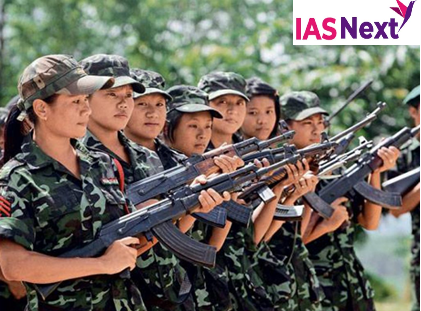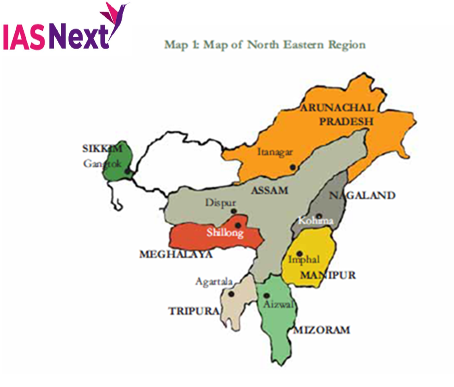CURRENT AFFAIRS
Get the most updated and recent current affair content on Padhaikaro.com
Insurgency situation in North East India
- IAS NEXT, Lucknow
- 01, Nov 2021

To prepare for INTERNAL SECURITY for UPSC-IAS/UPPSC, Students have to know about Insurgency/Crisis in North-East India.
It is important topic for Civil services Mains paper 3 topic Internal security.
The Northeast region of India comprising of eight states – Assam, Nagaland, Manipur, Arunachal Pradesh, Mizoram, Tripura and Sikkim.
North East India is a region poorly connected to the Indian mainland by a small corridor – Siliguri Corridor (also known as Chicken Neck – with a narrow width of only 21 kilometers).
North-Eastern India has been facing problems of insurgency for near 7 decades.
North-East India shares international borders with China and Bhutan on its North, Myanmar on its East and Bangladesh on its south and western side.
The Northeast region with 99 percent of its boundary being the international border, the problems and peculiarities are even more accentuated.
Located in the eastern most corner of India, the region is home to different indigenous communities reflecting diversity in lifestyles and social customs. The North Eastern Region comprises of about India’s 8% land area and around 3% of the population of the country.

Of the 6 international borders that India shares with its neighbours, the North Eastern Region shares borders with all except Pakistan. The North Eastern Region is cradled by the 5 Asian states namely – Nepal, Bhutan, China, Bangladesh and Myanmar.
The North Eastern Region of India is known for its huge reservoirs of rich natural resources as region is endowed with diverse biodiversity, fossil fuel, coal limestone, forest resources with exceptional variety of flora and fauna. The North Eastern Region encompasses 30% of India’s flora and more than 30% of the total water wealth of the country.
North East India is characterized by social, cultural, political, geographical and historical diversities. These diversities resulted in lack of integration and accumulation both intra region-wise and inter region-wise. It has 475 ethnic groups and 400 languages/ dialects are spoken here.
Lack of physical infrastructure, intra territorial conflicts, ethnic unrest and insurgency has prevented both public and private investments to take place, thus easing the scenario of backwardness to continue.
History of conflicts in North Eastern Part of India
According to the Report of the 2nd Administrative Reforms Commission the Northeast represents a state of stable anarchy where the rule of law and other institutions of governance are subverted directly or through collusive arrangements to serve personal or partisan ends of the militants.
Regional issues: The inter-tribal conflicts, the youth unemployment and the inability to compete with non-tribal businesses, illegal migration from neighbouring States and countries leading to the competition of resources and land have led to various conflicts and demands of secession/ autonomy.
Gaps at national level: The broad racial differences between India and its Northeast and the tenuous geographical link (the chicken neck Siliguri Corridor) contributed to a sense of alienation, a feeling of ‘otherness’ that subsequently gave rise to a political culture of violent separatism.
Ethnic tensions: Northeast India is home to more than 50 ethnic rebel groups – a few demanding complete secessions from India, others fighting for ethnic identities and homelands and some running the insurgency as an industry to spin easy money without any political ideology.
Militants in their formative years voiced genuine grievances of the people such as poor governance, alienation, lack of development and an apathetic attitude from the central government in New Delhi. However, with time and opportunist motives, these have taken forms of insurgencies across the region.